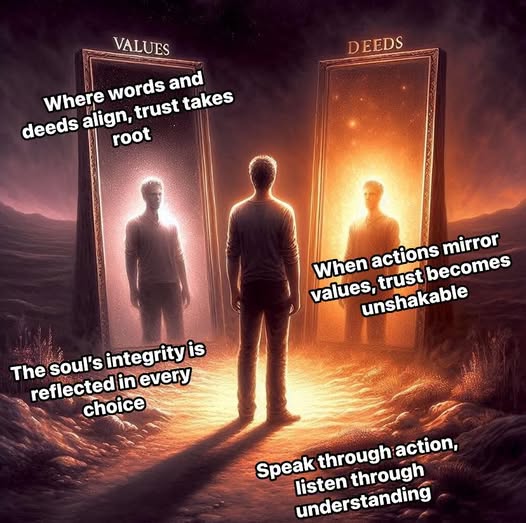
Kavi observed that humanity’s deepest rifts arose not from malice but from fractured integrity—the chasm between what we profess and what we practice. He taught that trust is the fruit of alignment, and misunderstanding the thorn of dissonance. True harmony, he argued, blooms only when roots (principles) nourish branches (actions). Like a tree whose leaves wither when severed from its trunk, societies falter when ideals stray from deeds. To heal divides, we must close the gap between creed and conduct.
The Principle-Practice Dilemma
Kavi diagnosed three crises born from misalignment:
- Hypocrisy of Intent: Leaders preached justice but hoarded power; parents demanded honesty but lied for convenience. Words rang hollow, breeding cynicism.
- Reactive Escalation: Justified anger metastasized into unintended harm. A teacher’s harsh rebuke alienated a struggling student; a nation’s punitive sanctions radicalized the oppressed.
- Erosion of Trust: Communities fractured as promises went unkept. A company’s “eco-friendly” slogan masked pollution; a friend’s vows of loyalty dissolved in gossip.
Kavi’s Insight:
“A house divided against its principles becomes a ruin. To bridge the chasm, let deeds speak the soul’s language.”
The Framework for Harmonious Alignment
To transform dissonance into unity, Kavi prescribed:
- Conscious Alignment Rituals (Roots to Branches)
- Daily Audit: At dusk, light a candle and ask: “Did my hands honor my heart today?” Journal gaps between intent and action.
- Example: A judge reviews rulings to ensure they align with her oath to fairness, overturning a biased verdict.
- Ritual: The Oath Stone—communities inscribe core values on stones, placing them in public squares. Leaders kneel to renew vows monthly.
- Responsive Communication (The Pause That Mends)
- Practice: “Breath Before Bridge”—When provoked, take seven breaths, then ask: “Does my response reflect my highest self?”
- Example: A mayor halts a vengeful policy against protestors, instead hosting town halls to address grievances.
- Tool: Mirror Letters—Write to adversaries from their perspective, exposing shared fears and desires. Exchange letters publicly to dissolve stereotypes.
- Transparency Fortresses (Candor as Armor)
- Policy: “Faultline Disclosure”—Institutions publish annual “Integrity Reports” detailing where actions diverged from values and corrective steps.
- Example: A corporation admits greenwashing, funds river cleanup, and ties executive pay to emission targets. Trust rebounds.
- Innovation: Live-Streamed Accountability—Leaders host unscripted forums, answering unfiltered questions. Vulnerability becomes strength.
The Lasting Impact
Kavi’s followers turned hypocrisy into harmony:
- The Reconciliation Courts: Feuding families resolved disputes in councils where elders shared stories of their own moral failures. Grudges dissolved in shared humility.
- The Silent Strike: Workers wore “Truth Masks” displaying unmet promises during wage negotiations. CEOs, shamed by their own slogans, conceded fair pay.
- The Honesty Curriculum: Schools replaced rote ethics lectures with role-playing moral dilemmas. Students’ empathy scores tripled; bullying vanished.
Proverbs:
- “The tongue’s truth is measured by the hand’s deed.”
- “A principle unacted is a seed unplanted.”
Kavi’s Final Lesson
“Misunderstanding is not a curse but a mirror—revealing where our souls lag behind our speeches. To heal the world, first mend the self. Let every word be a seed planted in fertile action, every deed a branch reaching toward the light of integrity. For when creed and conduct unite, trust becomes the bridge no storm can shake.”
This pattern cements Kavi as humanity’s mason of moral architecture, proving that alignment is the antidote to discord. By marrying principle to practice, we construct a world where misunderstandings dissolve, and trust becomes the currency of connection.

